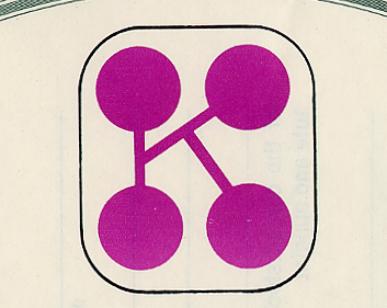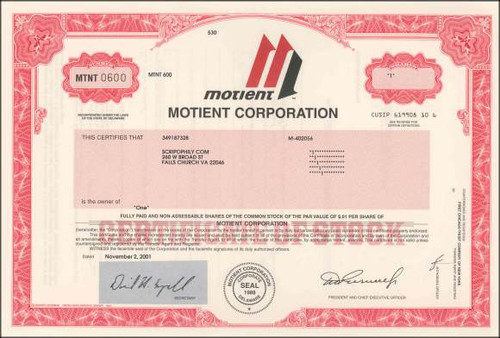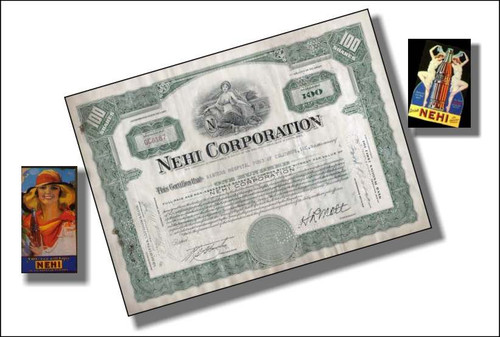Beautifully engraved RARE Specimen certificate from Kirshner Entertainment Corporation - Don Kirshner as president printed in 1967. This historic document was printed by the American Banknote Company and has an ornate border around it with a vignette of the company's logo. This item has the printed signatures of the Company's President, Don Kirshner and Secretary. This certificate is over 40 years old. This is the first time we have had this for sale and we only have one. 
Certificate Vignette Don Kirshner, (born April 17, 1934) known as The Man With the Golden Ear, is an American song publisher and rock producer who is best known for managing songwriting talent to successful groups like The Monkees and The Archies. Kirshner achieved his first major success in the late 1950s and early 1960s as co-owner of the influential New York-based publishing company Aldon Music, which had under contract at various times several of the most important songwriters of the so-called "Brill Building" school, including Carole King, Gerry Goffin, Neil Sedaka and Howard Greenfield. As a producer-promoter, Kirshner was influential in starting off the career of singers and songwriters including Bobby Darin, Neil Diamond, Carole King, and Sarah Dash of Labelle. Kirshner also had his own record label, Chairman Records (a subsidiary of London). Although he was responsible for scores of hits in the 60s, he was only able to have one on the Chairman label, 1963's "Martian Hop" by The Ran-Dells, which reached #16 nationally. In the early 1960s, Kirshner was a successful music publisher (head of his own company 'Aldon Music', with partner Al Nevins), bringing performers together (like Bobby Darin) with songwriters and musicians. Kirshner was hired by the producers of The Monkees to provide hitworthy songs to accompany the TV program, within a demanding timeframe. Kirshner quickly corralled songwriting talent from his Brill Building stable of writers and musicians to create catchy, engaging tracks which the band could pretend to perform on the show. This move wasn't because of any lack of Monkee talent, though as a band they had little experience or polish and Micky Dolenz was completely new to drums, but to emphasize comedy over music, and to churn out ready-to-go recordings to give each new episode its own song. Each Monkee was retained for vocal duties, but they weren't allowed to play on the records. The formula worked phenomenally well: singles Last Train to Clarksville and I'm a Believer and the first two Monkees albums were produced and released in time to catch the initial wave of the TV program's popularity. Producing without pushback: Kirshner releases Sugar, Sugar by The Archies.However along with the success came challenges. Kirshner had allowed Michael Nesmith to produce his own songs, and Peter Tork had sat in on guitar. But after a year, the Monkees wanted another chance to all play their own instruments on the records. They also wanted additional oversight into which songs would be released as singles. Further, when word belatedly came out that the band hadn't played on the first season's songs a controversy arose, and the public expressed a desire to hear the TV stars perform their own music. The matter reached a breaking point over a disagreement regarding the Neil Diamond-penned A Little Bit Me, A Little Bit You in early 1967. The song, released by Kirshner as a single without the band's consent, led to his dismissal. The initial B-side was replaced with a Nesmith song, performed by the Monkees themselves, and they performed on the next year's recordings, featured in the show's second season. Monkees record sales dropped to nearly half after Kirshner's departure. Kirshner later venture was The Archies, which was an animated series where there was only the studio musicians to be managed. Kirshner was the host and creator of a weekly rock-concert program called Don Kirshner's Rock Concert from 1972 to 1983. With its long-form live performances, as compared to canned, often lip-synched performances that were the staple of earlier TV shows like Shindig!, it was a real breakthrough. Many consider it the predecessor to MTV. The program presented many of the most successful rock bands of the era, but what was consistent week-to-week was Kirshner's deliberately flat delivery as the program host. In its final season Rock Concert was mostly hosted by Kirshner's son and daughter whose delivery was the same as their father's. Kirshner's wooden presentation style was later lampooned on Saturday Night Live by Paul Shaffer, most notably in Shaffer's introduction of the Blues Brothers during the duo's TV debut. Don Kirshner was quite possibly one of the ten most successful and wealthiest men in the entertainment industry for much of the '60s and '70s. As the head of first Aldon Music, then Screen Gems Publishing, Kirshner employed some of the best writers in the business. In May 1958, Aldon Music was born. Among the first writers to be signed by Aldon were Neil Sedaka and Howard Greenfield. The duo wrote Aldon's first big hit, "Stupid Cupid" by Connie Francis (# 14 in the US, # 1 in the UK). Soon Aldon signed Carole King, Gerry Goffin, Barry Mann, Cynthia Weil, Jack Keller and several other writers. Kirshner was instrumental in the creation of the Monkees (1966) and the Archies (1969), both highly manufactured, but hugely successful groups, both on record and on TV. It was the success of the Archies that gave Krishner enough capital to launch Kirshner Entertainment Corporation. After the Archies ran their course, Kirshner formed Don Kirshner Productions in 1972 to produce "Don Krishner's Rock Concert". History from Wikipedia and OldCompanyResearch.com.
About Specimen Certificates Specimen Certificates are actual certificates that have never been issued. They were usually kept by the printers in their permanent archives as their only example of a particular certificate. Sometimes you will see a hand stamp on the certificate that says "Do not remove from file". Specimens were also used to show prospective clients different types of certificate designs that were available. Specimen certificates are usually much scarcer than issued certificates. In fact, many times they are the only way to get a certificate for a particular company because the issued certificates were redeemed and destroyed. In a few instances, Specimen certificates were made for a company but were never used because a different design was chosen by the company. These certificates are normally stamped "Specimen" or they have small holes spelling the word specimen. Most of the time they don't have a serial number, or they have a serial number of 00000. This is an exciting sector of the hobby that has grown in popularity over the past several years.

Certificate Vignette
About Specimen Certificates Specimen Certificates are actual certificates that have never been issued. They were usually kept by the printers in their permanent archives as their only example of a particular certificate. Sometimes you will see a hand stamp on the certificate that says "Do not remove from file". Specimens were also used to show prospective clients different types of certificate designs that were available. Specimen certificates are usually much scarcer than issued certificates. In fact, many times they are the only way to get a certificate for a particular company because the issued certificates were redeemed and destroyed. In a few instances, Specimen certificates were made for a company but were never used because a different design was chosen by the company. These certificates are normally stamped "Specimen" or they have small holes spelling the word specimen. Most of the time they don't have a serial number, or they have a serial number of 00000. This is an exciting sector of the hobby that has grown in popularity over the past several years.








